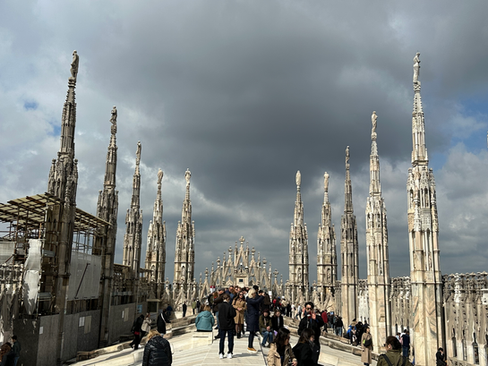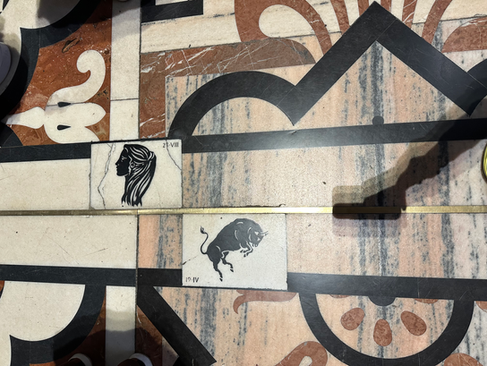Touring the Iconic Milan Cathedral, Il Duomo di Milano
- Ben
- Apr 25, 2024
- 5 min read
Updated: Aug 11, 2024
The Milan Cathedral is one of the most awesome architectural wonders I've ever seen. It's the largest church in Italy... only because the Vatican, which houses St. Peter's Basilica, is a different country. It's also the third largest church in the world behind St. Peter's and Cathedral Basilica in Aparecida, Brazil.

When was the Milan Cathedral built?
Construction on the Cathedral began in 1386, and they finished putting the "final touches" on the building in 1965. That's almost 600 years later! But to be honest, the Milan Duomo is really never finished. It's constantly undergoing renovations and maintenance. Keep this in mind as a tourist, as there is sure to be scaffolding somewhere when you visit. As long as it's not on the front, that's the best you can hope for.
Because its construction and upkeep is fully funded by resident taxes (and donations), it's a slow process. I was pretty surprised to learn taxes go to the Milan Cathedral - separation of church and state is a much different and equally complicated issue in Italy as here in the U.S. - but residents take pride in the beauty of their iconic Cathedral, and our tour guide assured us they were happy to pay for its upkeep.
The 3,400+ Unique Statues on the Milan Cathedral
The Duomo of Milano is made of brick on the inside and Candoglia marble from the nearby Piedmonte region of Italy on the exterior. Because the marble itself is not strong enough to support the weight of the Cathedral's roof, the brick underneath provides extra strength.
The Cathedral has 135 spires, each of which is a gorgeous work of art on its own. There are more than 3,400 statues, and each statue on the Duomo of Milan are all handmade and unique! When one gets damaged, someone has to hand-carve a replica as a replacement.
The original statues that have been removed are available for viewing in the Duomo Museum next door, which I highly recommend. Most tickets for the Duomo tour include the entrance fee to the museum, so save an hour or so, and enjoy an up-close view of the statues.
One other interesting fact about the Candoglia marble is its scarcity. Because the quarry is relatively small, the Government of Milan owns the whole thing. The marble is needed for replacements on the Cathedral, and the remaining stone needs to be rationed. So aside from a few local and centuries-old cathedrals and sculptures, this particular marble can only be found here at the Milan Cathedral.
Cleaning the Milan Cathedral
Why are some parts of the Duomo blindingly white and other parts are dirty and gray? The marble is unfortunately really porous, so it gets dust and debris stuck on it easily. The main problem is how long it takes to clean. How difficult is it to clean the Duomo? Extremely. Because the marble is also very soft and prone to erosion, the entire Milan Cathedral is cleaned exclusively with air!
As our guide told us, workers literally clean it inch-by-inch by blowing compressed air on it to separate the dirt from the marble facade. Can you imagine? Cleaning this massive structure with, essentially, the air duster you use to get crumbs out of your laptop keyboard? No wonder why it's a constant process. When they finish cleaning the final part, it'll be time to start back at the beginning again.
The Rooftop of the Milan Cathedral
When you book a tour to visit the Duomo of Milano, you can choose just rooftop access, just interior access, or both interior and rooftop. You have to do the roof. Seeing the spires up close was amazing. You get to walk all around the Cathedral at different heights and, at the end, hang out on the main roof area. The views are awesome, and the spires are so impressive. Best of all, though, is probably the statue, which is the highest point of Milan.
The Madonnina atop the Duomo of Milano
From the roof of the Milan Cathedral, you also get a great view of the statue of the Virgin Mary, or in Italian, Madonna. The statute is actually called the "Little Mary" or "Madonnina" despite being over 13 feet tall. It was erected in 1774 and is made of hollow copper with gold leaf. The Madonnina is a religious symbol of the city, and as such, it is illegal to build anything taller than her. The city doesn't have any skyscraper for this reason. The tallest buildings in Milan are just shy the 354-foot mark of the Madonnina's peak.
Unfortunately the weather wasn't great for our visit. It was a bit cold and rainy, and the top of the Milan Cathedral was super windy. Be sure to wear layers when you visit!
The Interior of the Milan Cathedral
The tour finishes back at ground level inside the Cathedral. I thought I wouldn't be that impressed - what could be better than the rooftop? - but the inside was really nice. For one thing, the columns and vaulted ceiling were beautiful.

For another, the organ, the confessional, and the stained glass windows were gorgeous. The stained glass windows in the back, we were told, is actually nicer and more intricate than what is at the front of the Duomo. They started building in the back, and by the time they got to the front, they had run out of time of money or something, so the stained glass is much simpler. When you visit the Milan Cathedral, make sure you walk around to the back to see the best stained glass the Duomo has to offer.
Finally, the floor of the Milan Duomo was amazing. It must have taken so long to install, and all the different colors were gorgeous. It is quite uneven because the white Candoglia marble is softer and much more eroded than the other marble varieties.
The floor of the Cathedral also had an inlaid solar calendar, which is really cool. It's a long brass strip with inlaid marble designs of all twelve zodiac signs. There's a small hole in the roof of the Cathedral, and when the sun comes through at the right time, it'll tell you which month it is. Unfortunately, it's not terribly accurate anymore, since it was installed in 1786, but it is still a beautiful feature.
Final Thoughts
The Milan Cathedral is a stunning architectural wonder, and it's definitely worth a visit. If you're anywhere near Milan, be sure to pop in to see Milan's best feature. Be sure to book your tickets early, as you're unlikely to get a same-day appointment. And when you go, plan a little extra time to enjoy the museum and the next-door galleria.














































